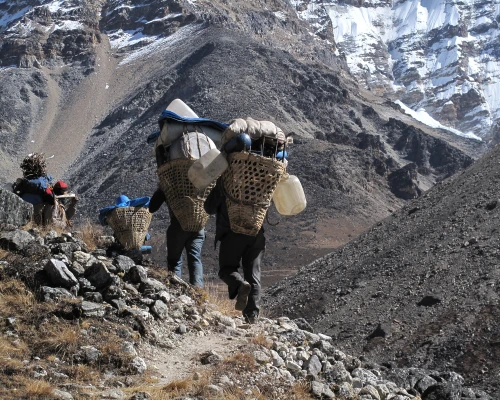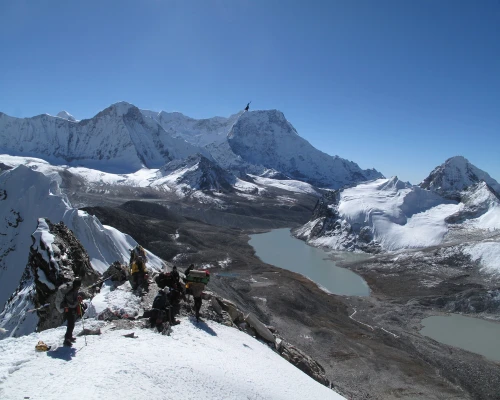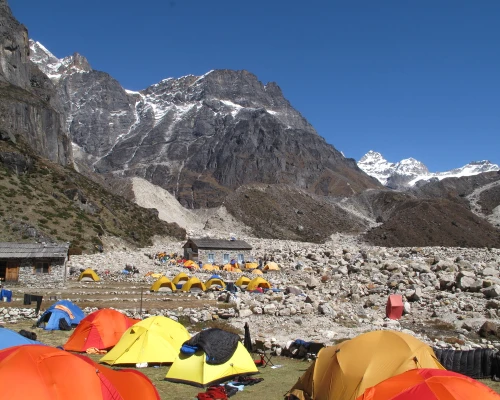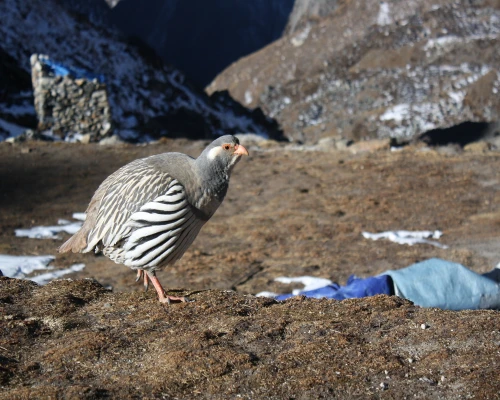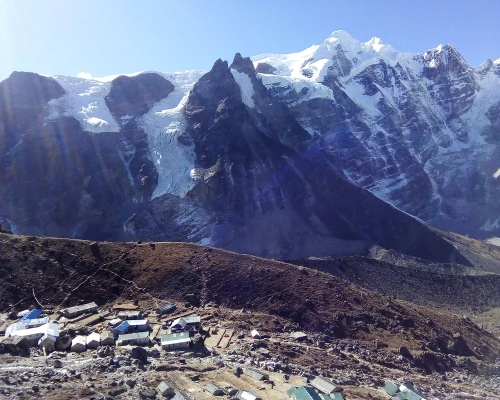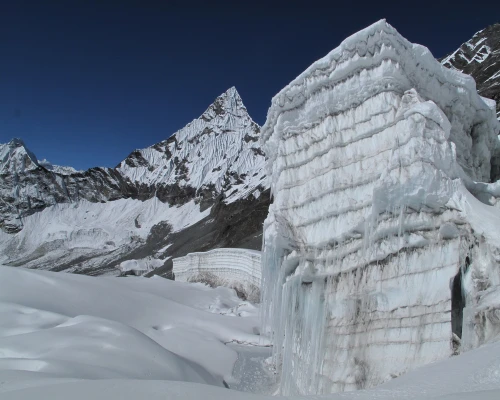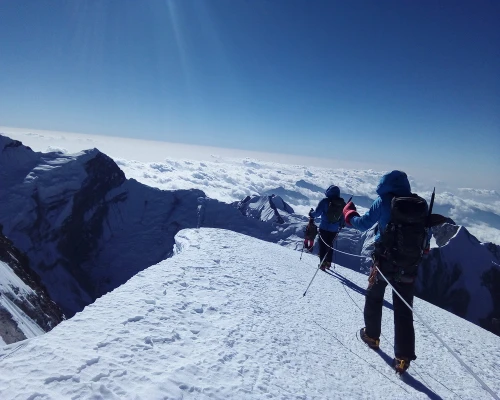Mera Peak climbing expedition is a thrilling adventure in Nepal, allowing both experienced climbers and novices with good fitness levels to conquer this non technical mountain. It is an ideal choice for adventure enthusiasts seeking entry into the world of mountaineering. The journey begins with a trek to Thuli Kharka (4,300m) via the captivating Zatrawala Pass. After an overnight stay in Thuli Kharka, the trek continues to Kothe. From Kothe, an early morning departure leads to Thangnak (4,326m). After spending a night in Thangnak, the next destination is Khare.
The trekking trail to Mera Peak offers a delightful mix of terrains, including river banks, picturesque valleys, enchanting forests, alpine landscapes, glacial lakes, glacier moraines, and a snow climb with an elevation of less than 30 degrees. Compared to many other mountain climbs, the ascent is relatively easier. Upon reaching the summit of Mera Peak (6,476m/21,247ft), adventurers are rewarded with a breathtaking panorama that includes five of the six highest mountains on earth: Mt. Cho Oyu (8,201m), Mt. Lhotse (8,516m), Mt. Everest (8,848m), Mt. Makalu (8,463m), and Mt. Kangchenjunga (8,586m).
At Mera Base Camp (Khare), the climbing leader provides instruction on ice climbing techniques, rope techniques, crampon usage on ice, and climbing gear. Prior experience in ice climbing or technical climbing knowledge is not mandatory for ascending Mera Peak.
- Embark on an unforgettable adventure by climbing the highest trekking peak in Nepal, Mera Peak, accompanied by a skilled and experienced local Sherpa crew. This carefully crafted itinerary spans 14 days, making it the shortest route to conquer Mera Peak.
- Your journey will take you through the captivating landscapes of the Khumbu Valley, renowned for its rich Sherpa culture, and the rarely explored Hinku Valley, offering a unique and off-the-beaten-path experience. Along the way, you will encounter the breathtaking Zatrwa La high mountain pass, as well as several awe-inspiring glaciers that dot the route.
- The ascent to Mera Peak follows a straightforward path with minimal technical climbing, allowing you to focus on the sheer beauty of the surrounding environment. Upon reaching the summit, you will be rewarded with close-up views of five of the world's highest peaks: Mount Everest, Kanchenjunga, Lhotse, Cho Oyu, and Makalu. This remarkable sight is sure to leave an indelible mark on your memory.
- To ensure your safety and success, your climbing guide is a highly experienced mountaineer, having summited Mount Everest and possessing over two decades of mountaineering expertise. With their guidance and support, you can embark on this exhilarating journey with confidence and peace of mind.
Embark on an exhilarating adventure in Nepal and conquer the summit of Mera Peak, soaring 6,400 meters above sea level.
Mera Peak Climb Overview
Mera Peak Climb, the tallest trekking peak in Nepal, is a highly sought-after destination for climbers from around the world. Located in the majestic Everest region, Mera Peak has been a popular choice for mountaineers since its inception. It lies in the Mahalangur section of the Himalayas, the north estern part of the Solukhumbu region of Nepal. Mera Peak comprises three main summits: Mera Central (6,476m), Mera North (6,476m), and Mera South (6,065m).
Renowned climbers Tenzing Norgay Sherpa and Sir Edmund Hillary, the first to conquer Mount Everest, set the trend of climbing Mera Peak before and after their Everest ascent. Since then, its popularity has continued to grow, attracting climbers from all over the world. Mera Peak climbing is often seen as a stepping stone to prepare for an Everest climb.
Each year, thousands of climbers flock to Nepal specifically for Mera Peak climbing, with a significant portion being beginners in mountaineering. The climbing and technical aspects of Mera Peak make it an ideal choice for novice climbers to embark on their climbing journey. It is widely regarded as the best mountain to start one's climbing adventure.
Amateur climbers have the opportunity to learn how to use crampons, ice axes, and other mountaineering gear for the first time during the Mera Peak climb. However, the experience is not solely focused on the ascent and descent. The journey to Mera Peak is a long but breathtaking exploration of one of the most beautiful regions in the world.
Reaching the summit of Mera Peak offers an up-close view of four of the world's eight-thousanders: Mount Everest (8,848m), Mount Makalu (8,643m), Mount Cho Oyu (8,201m), and Mount Lhotse (8,586m). Being surrounded by these majestic peaks throughout the day is a dream come true for any mountain lover.
The journey to Mera Peak takes you through the iconic Khumbu region, which offers a blend of unique Sherpa settlements, lush forests, picturesque suspension bridges, traditional gompas (monasteries), prayer flags, and much more. It is difficult to capture in words the array of experiences this Mera Peak climbing expedition has to offer.
If you're considering booking the Mera Peak expedition, we, Peak Climbing Nepal, assure you that you won't miss a single thing in this region when you choose us as your guide. However, before making the booking, it is important to familiarize yourself with several aspects of Mera Peak climbing. This article provides detailed information about the route, the best time to climb, challenges, a comprehensive itinerary, and frequently asked questions. Take the time to read this article thoroughly before contacting us for the booking.
Mera Peak Climbing Difficulty
Mera Peak Climbing is a less challenging expedition, but climbers should be aware of the potential difficulties involved due to weather. As you ascend toward the summit of Nepal's tallest trekking peak, the risk of altitude sickness becomes significant. The journey covers approximately 78 miles of rugged terrain in the Everest Region, which includes rough, steep, snowy, and straightforward sections. These varied trail conditions can be demanding for climbers. It's important to note that the entire expedition is completed in just 12 days, which leaves less time for acclimatization compared to other Mera Peak Climbing itineraries that typically include two acclimatization days. The reduced acclimatization time can pose a challenge and increase the risk of altitude-related illnesses.
While Mera Peak is not considered highly technical, it is graded as a PD Alpine Graded peak, indicating that it does have some technical sections and requires basic mountaineering skills. Climbers without these skills may find certain parts of the climb more challenging. Additionally, like any mountain expedition, extreme weather conditions are expected. In the higher regions of the Everest Region, you will encounter low temperatures and strong winds. As you gain elevation, the weather conditions tend to worsen. Throughout the journey, you will be living in tented camps, exposing yourself to the elements.
In summary, Mera Peak Climbing presents challenges such as altitude sickness, rugged terrain, limited acclimatization time, technical sections, and extreme weather conditions. Proper preparation, acclimatization, mountaineering skills, and suitable equipment are crucial for a safe and successful climb.
Route to Mera Peak Climbing
The Mera Peak Climbing journey begins in Kathmandu, where you will catch an early morning flight of approximately 35 minutes to Lukla, providing an escape from the bustling streets of the city. Upon landing in Lukla, you will join the trekking trail that leads towards Chhutang. Your first overnight stop will be in Chhutang, allowing you to acclimatize to the altitude.
The following day, you will continue your trek towards Thuli Kharka, located at an elevation of 4,300 meters. Along the way, you will pass through various settlements in the Everest Region, including Kothe, Thangnak, and Khare. It is in Khare that you will take a rest day to further acclimate to the higher altitudes, preparing your body for the ascent.
Once your body is acclimatized, you will head towards Mera Base Camp, navigating the snowy trails and enjoying the stunning mountain vistas. From Mera Base Camp, the trail becomes steeper and more challenging as you make your way to Mera High Camp at an altitude of 5,780 meters. This part of the climb involves technical sections and the use of mountaineering gear and fixed ropes.
Finally, from Mera High Camp, you will embark on the summit push, aiming to reach the top of Mera Peak. The route to the summit is primarily straightforward, but it requires careful navigation and the application of your mountaineering skills. Once you reach the summit, you will savor the experience and spend some time taking in the incredible views. Afterward, you will gradually descend, retracing your steps back to Lukla through the same route you took during the ascent. Over the course of a few days, you will make your way back to Lukla, bidding farewell to the Mera Peak's foothills. From Lukla, you will catch a flight back to Kathmandu, concluding this extraordinary expedition.
Best Time to Climb Mera Peak
The best times for Mera Peak climbing are Spring (March to May) and Autumn (September to early December) in Nepal. These seasons offer favorable weather conditions with stable temperatures, clear views, and lower chances of snowfall. Spring is known for its warm weather and low snowfall, while Autumn provides comfortable temperatures and clear skies.
Both Spring and Autumn are popular seasons for climbing Mera Peak, and many adventurers choose these times for their expeditions. The landscapes in Autumn may appear more distinct due to being post-monsoon, and the late Autumn season can be colder compared to Spring. However, overall, both seasons are suitable for climbing the peak.
It's worth noting that Winter and Monsoon are considered off-season for climbing in Nepal. While experienced climbers may opt for these times, they come with higher risks, as they are characterized by extreme weather and challenging conditions. Climbing during these off-seasons is typically recommended for individuals with extensive experience and expertise. In conclusion, if you're planning to undertake a Short Mera Peak climbing expedition, it is advisable to choose either Spring or Autumn for the best climbing conditions and overall safety.
Why Nepal Nomad
Nepal Nomad is a trusted adventure company that has been catering to the needs of adventurers for more than 19 years. Whether you're looking for trekking, climbing, or travel experiences in Nepal, we aim to fulfill your desires. With a team of experienced and professional guides and porters, Nepal Nomad ensures that you have exceptional experiences throughout your journey.
The guides and porters of Nepal Nomad are well-trained in various essential skills, including evacuation procedures, map-reading, and first-aid services. Our expertise and knowledge contribute to the safety and well-being of travelers during their trips. The company prioritizes excellence in all aspects of its services, and its commitment to providing exceptional experiences has resulted in the satisfaction of nomads from around the world who have chosen to travel with them. With Nepal Nomad, you can expect a reliable and dedicated team that is focused on making your adventure in Nepal memorable and fulfilling.



